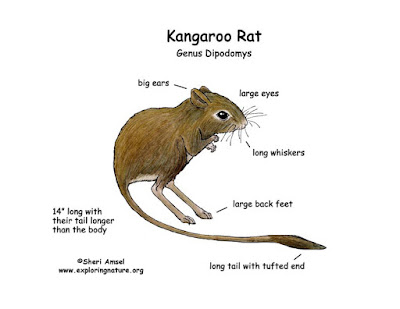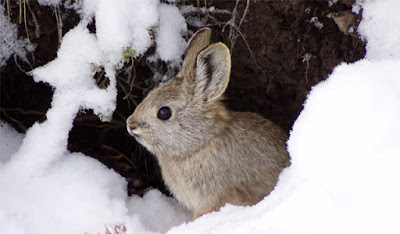Northern Idaho Ground Squirrel : Hailey Bohmaker
Northern Idaho Ground Squirrel
(Spermophilus brunneus brunneus)
*Hailey Bohmaker BIO 227 |
Description:
Spermophilus
brunneus brunneus, otherwise known as the Northern Idaho Ground Squirrel is a member
of the genus Spermophilus and is generally small in size. It is 1 of 2 subspecies of the Idaho ground squirrel,
which is native to Idaho.The average male length
is approximately 23.4 centimeters, and the average female length is 22.6
centimeters. Northern Idaho Ground Squirrel’s coats appear to be a dark reddish
tint due to a blend of black and yellow hair along with dark red spots. This species has a short, narrow tail, tan feet and ears, and a grey-brown throat. There is a ring of white located
around both eyes of the subspecies.
Ecology:
 |
| U.S. Fish and Wildlife Service |
Geographic and Population Changes:
 |
| Range of the northern Idaho ground squirrel. (Idaho Department of Fish and Game 1997) |
 |
Northern Idaho ground squirrel
probable historical distribution map (U.S. Forest Service 2003). |
Cause of Listing & Main Threats to existence:
The Northern Idaho Ground Squirrel was listed as a threatened species on April 5, 2000. The main threats to existence and cause of listing are:
The Northern Idaho Ground Squirrel was listed as a threatened species on April 5, 2000. The main threats to existence and cause of listing are:
 |
| Columbian Ground Squirrel |
- Primary threat is meadow invasion by conifers, which causes habitat fragmentation: Increased fires and the regrowth of conifers resulting from previous logging activities have reduced meadow habitats suitable for this species.
- Overexploitation for commercial, recreational, scientific, or educational purposes: Recreational shooting and scientific research
- Disease and predation: parasites, badgers, northern goshawk, prairie falcon
- Inadequacy of existing regulatory mechanisms: safety from recreational shooting has not been very enforced
- Other natural or manmade factors affecting continued existence: competition from Columbian Ground Squirrels
Recovery Plan:
Objective: "to improve the status of the
northern Idaho ground squirrel so the subspecies can be delisted" (U.S. Fish and Wildlife).
Steps:
- Restore and Maintain Habitats- vegetation management, thinning and burning, assess potential forestry techniques, monitor private lands, reseeding with native grass, live stock management
- Conduct Northern Idaho Ground Squirrel Population Actions- translocation into existing populations, reintroduction into former habitats, captive breeding, research, law enforcement, predator and competition management
- Monitor Habitat and Populations- monitor ecological succession, monitor annual population size, monitor sex ratios, determine reproductive rates
- Coordinate the Northern Idaho Ground Squirrel Recovery Program- establish interagency program coordinator, establish technical working group, develop public outreach program, create central database, "Establishment of northern Idaho ground squirrel as a Payette National Forest Management Indicator Species for grassland communities" ( U.S. Fish and Wildlife)
What can you do?
- Create a donation website where funds go directly to the recovery plan for Northern Idaho Ground Squirrels!
- STAY INFORMED!! Stay updated on the current status of Northern Idaho ground Squirrels
- Share your knowledge: by informing others you help spread awareness!
- Build support within your community!
Bibliography:
“Frequently Asked Questions.” U.S. Fish and Wildlife.
“Idaho Ground Squirrel.” Idaho Ground Squirrel - Facts, Diet, Habitat & Pictures on Animalia.bio, animalia.bio/idaho-ground-squirrel.
“Northern Idaho Ground Squirrel.” Inaturalist, www.inaturalist.org/taxa/179996-Urocitellus-brunneus/browse_photos+.
"Recovery Plan." U.S. Fish and Wildlife.
“Spermophilus Brunneus.” Animal Diversity, University of Michigan, animaldiversity.org/accounts/Spermophilus_brunneus/.



I really liked the species you chose. It is really cute. I liked how much information you included; you thoroughly covered all of the areas. Plus all your maps really helped. I liked how you included information we had learned it class. It was very readable. -Karah Bengs
ReplyDeleteThe format in the "Cause of Listing & Main Threats to existence" and "Recovery Plan" sections were really nicely done. I liked how you listed the main points in bold, but then went into the specifics which provided more depth. I found it interesting how the female lifespan is typically double the length of the male's lifespan, though this is definitely helpful and beneficial in reestablishing their population size, I am curious as to why this is. You stated that the primary threat to these ground squirrels was "meadow invasion by conifers, which causes habitat fragmentation;" what would be the best solution in removing conifers from the area without damaging other vital habitats? Also, I am curious as to what the population size has to reach in order for this species to be de-listed.
ReplyDelete-Sarah Bach
First of all, the species you chose is absolutely adorable. Additionally, the blog was easy to follow and well formatted. The difference between the 1.7 year male lifespan and 3.2 year female lifespan was very interesting to me. It certainly makes sense though, since males travel long distances to mate and are vulnerable to predators. Overall, very well done and informative. -Lucas Bartell
ReplyDeleteI thought it was really interesting that the size of the squirrel's litter ranges greatly and is so dependent on the fitness of the mother. Your formatting made the blog very easy to follow!
ReplyDelete-Haley Baquian